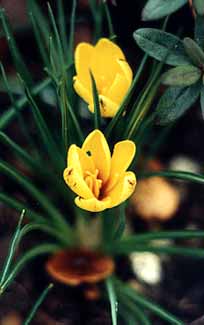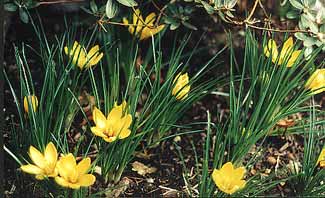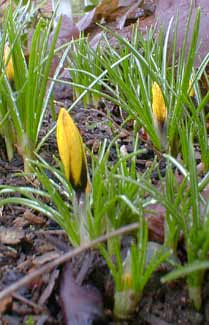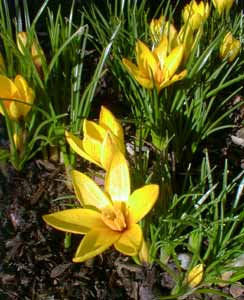 Crocus korolkowii
Crocus korolkowii
'Kiss of Spring'
"When first the crocus thrusts its point of gold
Up through the still snow-drifted garden mould,
And folded green things in dim woods unclose
Their crinkled spears, a sudden tremor goes
Into my veins & makes me kith & kin
To every wild-born thing that thrills & blows."
-"A Touch of Nature"
by Thomas Bailey Aldrich
(1836-1907)
by Thomas Bailey Aldrich
(1836-1907)
'Kiss of Spring' is a cultivar of the species crocus C. korolkowii, one of several similar forms available through bulb specialists. This bright yellow crocus has a mere whisper of magenta markings on the outer petals. Other named cultivars are generally distinguished by the outer petal markings so tend to look all the same viewed from above.
In general impression, the coloration of 'Kiss of Spring' is a pure yellow, any additional shading on the outer petals being invisible whenever the blossoms are fully opened on sunny days.
The species is named for General N. J. Korolkov, a Russian botanist who collected plants in Central Asia in the early 1870s, & for whom a gardened honeysuckle, a species iris, & other plants are named.
 It is native to subalpine areas of Kosovo, Afghanistan, northern Pakistan, Tajikistan & Uzbekistan. In its natural high-elevation settings it would experience cold snowy winters & dry summers, with its wonderful burst of color as snow is melting away in late winter or early spring.
It is native to subalpine areas of Kosovo, Afghanistan, northern Pakistan, Tajikistan & Uzbekistan. In its natural high-elevation settings it would experience cold snowy winters & dry summers, with its wonderful burst of color as snow is melting away in late winter or early spring.Usually sufficiently hardy to naturalize in the garden, there is some threat of rot in winter from too much rainfall, so excellent drainage is essential. Ours have survived & increased over time giving us the impression they are super-easy even in the winter-rainy Northwest. But other gardeners have reported that theirs did did not do so well until they were protected as container crocuses. I suspect that poor drainage is what causes a few gardeners to lose them.
It is sometimes recommended that a layer of pea-gravel be placed over them to insure surface dryness, though we've taken no such extra measures & they're doing superbly.
 In southern gardens they may fail to bloom some years, then do well other years, depending on whether or not they experienced enough cold winter days, for they do need to experience the seasonal changes.
In southern gardens they may fail to bloom some years, then do well other years, depending on whether or not they experienced enough cold winter days, for they do need to experience the seasonal changes.We planted ours in front of a dwarf rhododendron to the right of a drift of another species crocus, C. etruscus 'Zwanenburg,' where both get a great deal of morning sun & diffuse sunlight the rest of the day.
'Kiss of Spring' produces little clumps of crocus-grass by mid to late December. In winter of 2002/2003 it had colorful yellow buds by the first week of February, but was so slow to open the buds that its lilac neighbor 'Zwanenburg' caught up with it & opened into full bloom first. Their open blooms overlapped during late February & part of March, two strikingly contrasting drifts. The first two photos show 'Kiss of Spring' in February.
But for winter 2003/2004, 'Kiss of Spring' arrived much earlier than 'Zwanenburg,' perhaps because 'Kiss of Spring' hugely appreciated the three or four days it spent underneath snow, which doesn't happen every year. Plus there'd been a record-breaking hot summer to boot, which the species also appreciates. In 2004 it was blooming well before its lilac-colored neighbor. In 2005 it was flowering by mid-January, as did C. korolkowii 'Mountain's Glory' & C. ancyrensis 'Golden Bunch.'
 In 2004 it was in bright yellow bud by the second week in January, as shown in the third photo. Before the third week of January, several of the buds were already opening into full bloom. Because it was a very overcast month, the flowers re-closed & were pretty much bud-like for most days, their bright yellow serpent-heads remaining entirely shut on any day that lacked bright sun. The fourth photo shows it in January on one of the few sunny days. It was finished flowering in the third week of February save for scruffy remnants of yellow, & nearby 'Zwanenburg' was still going full guns.
In 2004 it was in bright yellow bud by the second week in January, as shown in the third photo. Before the third week of January, several of the buds were already opening into full bloom. Because it was a very overcast month, the flowers re-closed & were pretty much bud-like for most days, their bright yellow serpent-heads remaining entirely shut on any day that lacked bright sun. The fourth photo shows it in January on one of the few sunny days. It was finished flowering in the third week of February save for scruffy remnants of yellow, & nearby 'Zwanenburg' was still going full guns.While many of our snow-crocuses do have lots of grass by or before January, 'Kiss of Spring' gets ahead of the majority for big full buds & blooms. Curiously the majority of our early bloomers are the yellow ones, as C. chrysanthus 'Gypsy Girl' has also bloomed as early as mid-January. Two additional yellows are not quite so early, C. chrysanthus 'Goldilocks' begins a couple weeks later, & Crocus x luteus 'Stellaris' a full month after the earliest ones.
'Kiss of Spring' is awfully similar to these other yellow croci, but when in full wide-open bloom it distinguishes itself with more of a star-shape. Collectively these guarantee the presence of yellow crocuses of one kind or another from January through to the very end of March & even a little bit into April.